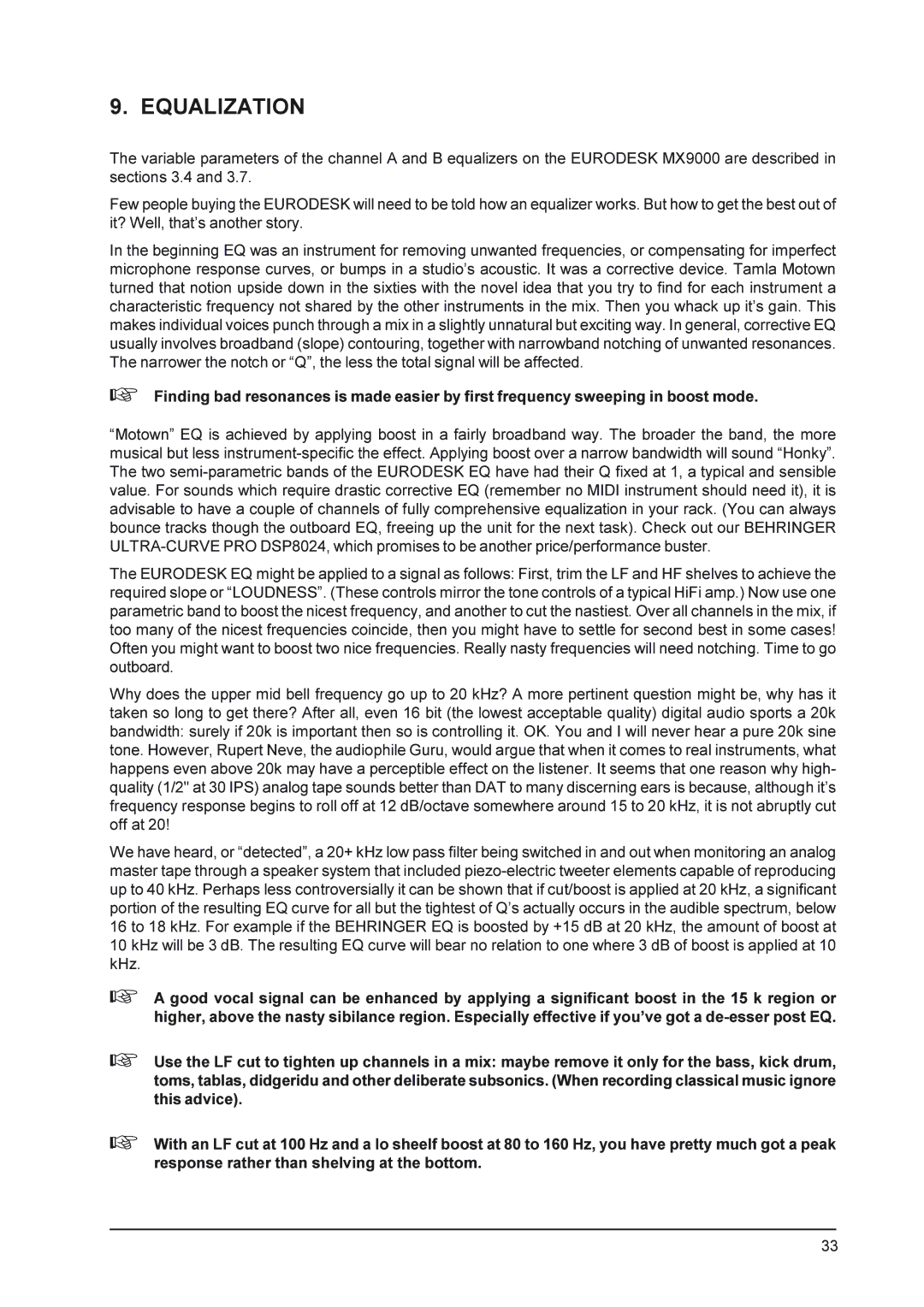9. EQUALIZATION
The variable parameters of the channel A and B equalizers on the EURODESK MX9000 are described in sections 3.4 and 3.7.
Few people buying the EURODESK will need to be told how an equalizer works. But how to get the best out of it? Well, that’s another story.
In the beginning EQ was an instrument for removing unwanted frequencies, or compensating for imperfect microphone response curves, or bumps in a studio’s acoustic. It was a corrective device. Tamla Motown turned that notion upside down in the sixties with the novel idea that you try to find for each instrument a characteristic frequency not shared by the other instruments in the mix. Then you whack up it’s gain. This makes individual voices punch through a mix in a slightly unnatural but exciting way. In general, corrective EQ usually involves broadband (slope) contouring, together with narrowband notching of unwanted resonances. The narrower the notch or “Q”, the less the total signal will be affected.
+Finding bad resonances is made easier by first frequency sweeping in boost mode.
“Motown” EQ is achieved by applying boost in a fairly broadband way. The broader the band, the more musical but less
The EURODESK EQ might be applied to a signal as follows: First, trim the LF and HF shelves to achieve the required slope or “LOUDNESS”. (These controls mirror the tone controls of a typical HiFi amp.) Now use one parametric band to boost the nicest frequency, and another to cut the nastiest. Over all channels in the mix, if too many of the nicest frequencies coincide, then you might have to settle for second best in some cases! Often you might want to boost two nice frequencies. Really nasty frequencies will need notching. Time to go outboard.
Why does the upper mid bell frequency go up to 20 kHz? A more pertinent question might be, why has it taken so long to get there? After all, even 16 bit (the lowest acceptable quality) digital audio sports a 20k bandwidth: surely if 20k is important then so is controlling it. OK. You and I will never hear a pure 20k sine tone. However, Rupert Neve, the audiophile Guru, would argue that when it comes to real instruments, what happens even above 20k may have a perceptible effect on the listener. It seems that one reason why high- quality (1/2" at 30 IPS) analog tape sounds better than DAT to many discerning ears is because, although it’s frequency response begins to roll off at 12 dB/octave somewhere around 15 to 20 kHz, it is not abruptly cut off at 20!
We have heard, or “detected”, a 20+ kHz low pass filter being switched in and out when monitoring an analog master tape through a speaker system that included
+A good vocal signal can be enhanced by applying a significant boost in the 15 k region or higher, above the nasty sibilance region. Especially effective if you’ve got a
+Use the LF cut to tighten up channels in a mix: maybe remove it only for the bass, kick drum, toms, tablas, didgeridu and other deliberate subsonics. (When recording classical music ignore this advice).
+With an LF cut at 100 Hz and a lo sheelf boost at 80 to 160 Hz, you have pretty much got a peak response rather than shelving at the bottom.
33
